Al-Azhar Mosque
| Al-Azhar Mosque | |
|---|---|
الجامع الأزهر | |
Ahmad al-Tayyeb | |
| Location | |
| Location | Cairo, Egypt |
| Geographic coordinates | 30°02′45″N 31°15′46″E / 30.045709°N 31.262683°E |
| Architecture | |
| Type | Mosque |
| Style | Islamic architecture, Fatimid, Mamluk |
| Date established | 972 |
| Specifications | |
| Capacity | 20,000 |
| Minaret(s) | 5 |
| Site area | 15,600 m2 (168,000 sq ft)[1] |
Al-Azhar Mosque (
After its dedication in 972, and with the hiring by mosque authorities of 35 scholars in 989, the mosque slowly developed into what it is today.
The affiliated
Over the course of its over a millennium-long history, the mosque has been alternately neglected and highly regarded. Because it was founded as a
Name
The city of Cairo was established by the Fatimid general
The mosque acquired its current name, al-ʾAzhar, sometime between the
An alternative theory is that the mosque's name is derived from the names given by the Fatimid caliphs to their palaces. Those near the mosque were collectively named al-Quṣūr al-Zāhira (القصور الزاهرة, "the Brilliant Palaces") by al-Aziz Billah, and the royal gardens were named after another derivative of the word zahra. The palaces had been completed and named prior to the mosque changing its name from Jāmiʿ al-Qāhira to al-ʾAzhar.[2][7]
The word Jāmiʿ is derived from the Arabic root word jamaʿa (g-m-ʿ), meaning "to gather". The word is used for large congregational mosques. While in classical Arabic the name for al-Azhar remains Jāmiʿ al-ʾAzhar, the pronunciation of the word Jāmiʿ changes to Gāmaʿ in Egyptian Arabic.[c]
History
Fatimid Caliphate

After the conquest of Egypt, Jawhar al-Siqilli oversaw the construction of the royal enclosure for the caliph's court and the Fatimid army, and had al-Azhar built as a base to spread Isma'ili Shi'a Islam.[9] Located near the densely populated Sunni city of Fustat, Cairo became the center of the Isma'ili sect of Shi'a Islam, and seat of the Fatimid empire.[10]
Jawhar ordered the construction of a congregational mosque for the new city and work commenced on April 4, 970.[6] The mosque was completed in 972 and the first Friday prayers were held there on June 22, 972 during Ramadan.[6]
Al-Azhar soon became a center of learning in the Islamic world, and official pronouncements and court sessions were issued from and convened there.
The mosque was expanded during the rule of the caliph al-Aziz Billah. According to al-Mufaddal, he ordered the restoration of portions of the mosque and had the ceiling raised by one cubit. The next Fatimid caliph, al-Hakim bi-Amr Allah (r. 996–1021), would continue to renovate the mosque, providing a new wooden door in 1010. However, al-Hakim's reign saw the completion of the al-Hakim Mosque, and al-Azhar lost its status as Cairo's primary congregational mosque. In May 1009 the al-Hakim Mosque became the sole location for the caliph's sermons; prior to this, al-Hakim would rotate where the Friday sermon was held. Following al-Hakim's reign, al-Azhar was restored by Caliph al-Mustansir Billah (r. 1036–1094). Additions and renovations were carried during the reign of the remaining Fatimid caliphs.[17] Caliph al-Hafiz undertook a major refurbishment in 1138, which established the keel-shaped arches and carved stucco decoration seen in the courtyard today, as well as the dome at the central entrance of the prayer hall.[18]
Initially lacking a library, al-Azhar was endowed by the Fatimid caliph in 1005 with thousands of manuscripts that formed the basis of its collection.
Ayyubid dynasty

In addition to stripping al-Azhar of its status as congregational mosque, Saladin also ordered the removal from the
The teaching center at the mosque also suffered.[20] The once well stocked library at al-Azhar was neglected, and manuscripts of Fatimid teachings that were held at al-Azhar were destroyed.[19][22] The Ayyubid dynasty promoted the teaching of Sunni theology in subsidized madrasas (schools) built throughout Cairo.[20] Student funding was withdrawn,[20] organized classes were no longer held at the mosque, and the professors that had prospered under the Fatimids were forced to find other means to earn their living.[22]
Al-Azhar nevertheless remained the seat of Arabic
Al-Azhar eventually adopted Saladin's educational reforms modeled on the college system he instituted, and its fortunes improved under the Mamluks, who restored student stipends and salaries for the shuyūkh (teaching staff).[19]
Mamluk Sultanate


Congregational prayers were reestablished at al-Azhar during the
An earthquake in 1302 caused damage to al-Azhar and a number of other mosques throughout Mamluk territory. The responsibility for reconstruction was split among the
Though the mosque had regained its standing in Cairo, repairs and additional work were carried out by those in positions lower than sultan. This changed under the rule of
Although the mosque-school was the leading university in the Islamic world and had regained royal patronage, it did not overtake the madrasas as the favored place of education among Cairo's elite. Al-Azhar maintained its reputation as an independent place of learning, whereas the madrasas that had first been constructed during Saladin's rule were fully integrated into the state educational system. Al-Azhar did continue to attract students from other areas in Egypt and the Middle East, far surpassing the numbers attending the madrasas.[30] Al-Azhar's student body was organized in riwaqs (fraternities) along national lines, and the branches of Islamic law were studied. The average degree required six years of study.[19]
By the 14th century, al-Azhar had achieved a preeminent place as the center for studies in law, theology, and Arabic, becoming a cynosure for students all around the Islamic world.
Province of the Ottoman Empire
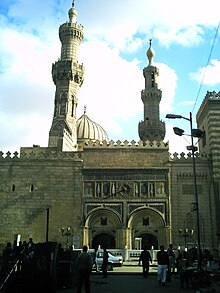
With the
Despite their defeat by Selim I and the Ottomans in 1517, the Mamluks remained influential in Egyptian society, becoming
Al-Qazdughli, a powerful Mamluk bey, sponsored several additions and renovations in the early 18th century. Under his direction, a riwaq for blind students was added in 1735. He also sponsored the rebuilding of the Turkish and Syrian riwaqs, both of which had originally been built by Qaytbay.[34]
This marked the beginning of the largest set of renovations to be undertaken since the expansions conducted under the Mamluk Sultanate. Abd al-Rahman Katkhuda was appointed katkhuda (head of the Janissaries) in 1749 and embarked on several projects throughout Cairo and at al-Azhar. Under his direction, three new gates were built: the Bab al-Muzayinīn (the Gate of the Barbers), so named because students would have their heads shaved outside of the gate, which eventually became the main entrance to the mosque; the Bab al-Sa'ayida (the Gate of the Sa'idis), named for the Sa'idi people of Upper Egypt; and, several years later, the Bab al-Shurba (the Soup Gate), from which food, often rice soup, would be served to the students. A prayer hall was added to the south of the original one, doubling the size of the available prayer space. Katkhuda also refurbished or rebuilt several of the riwaqs that surrounded the mosque. Katkhuda was buried in a mausoleum he himself had built in Al-Azhar; in 1776, he became the first person (and the last) to be interred within the mosque since Nafissa al-Bakriyya, a female mystic who had died around 1588.[35][36]
During the Ottoman period, al-Azhar regained its status as a favored institution of learning in Egypt, overtaking the madrasas that had been originally instituted by Saladin and greatly expanded by the Mamluks. By the end of the 18th century, al-Azhar had become inextricably linked to the ulema of Egypt.
Al-Azhar also served as a focal point for protests against the Ottoman occupation of Egypt, both from within the ulema and from among the general public. Student protests at al-Azhar were common, and shops in the vicinity of the mosque would often close out of solidarity with the students.
French occupation
Napoleon
People of Egypt, you will be told that I have come to destroy your religion: do not believe it! Answer that I have come to restore your rights and punish the usurpers, and that, more than the Mamluks, I respect God, his Prophet and the Koran ... Is it not we who have been through the centuries the friends of the Sultan?[43]
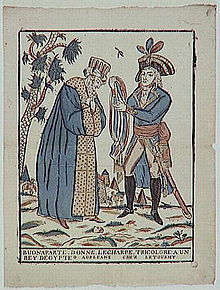
On July 25
Napoleon's efforts to win over both the Egyptians and the Ottomans proved unsuccessful; the Ottoman Empire declared war on 9 September 1798, and a revolt against French troops was launched from al-Azhar on 21 October 1798.
Napoleon, who had been well respected in Egypt and had earned himself the nickname Sultan el-Kebir (the Great Sultan) among the people of Cairo, lost their admiration and was no longer so addressed.
The conservative tradition of the mosque, with its lack of attention to science, was shaken by Napoleon's invasion. A seminal innovation occurred with the introduction of printing presses to Egypt, finally enabling the curriculum to shift from oral lectures and memorization to instruction by text, though the mosque itself only acquired its own printing press in 1930.
Muhammad Ali Dynasty and British occupation
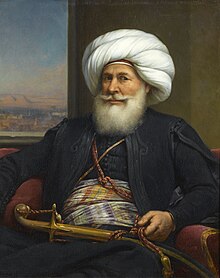
Following the French withdrawal, Ali, the
Ali also sought to limit the influence of the al-Azhar sheikhs by allocating positions within the government to those educated outside of al-Azhar. He sent select students to France to be educated under a Western system and created an educational system based on that model that was parallel to, and thus bypassed, the system of al-Azhar.[44]
Under the rule of
The reign of Isma'il Pasha also saw the return of royal patronage to al-Azhar. As khedive, Isma'il restored the Bab al-Sa'ayida (first built by Katkhuda) and the Madrasa al-Aqbughawiyya. Tewfik Pasha, Isma'il's son, who became khedive when his father was deposed as a result of British pressure, continued to restore the mosque. Tewfik renovated the prayer hall that was added by Katkhuda, aligned the southeastern facade of the hall with the street behind it, and remodeled the facade of the Madrasa al-Aqbughawiya along with several other areas of the mosque. Abbas Hilmi II succeeded his father Tewfik as khedive of Egypt and Sudan in 1892, and continued the renovations started by his grandfather Isma'il. He restructured the main facade of the mosque and built a new three-story riwaq in neo-Mamluk style along the mosque's southwestern corner (known as the Riwaq al-'Abbasi) which was completed in 1901. Under his rule, the Committee for the Conservation of Monuments of Arab Art (also known as the "Comité"), also restored the original Fatimid sahn. These renovations were both needed and helped modernize al-Azhar and harmonize it with what was becoming a metropolis.[58]

The major set of reforms that began under the rule of Isma'il Pasha continued under the British occupation.[59] Muhammad Mahdi al-'Abbasi, sheikh al-Azhar, had instituted a set of reforms in 1872 intended to provide structure to the hiring practices of the university as well as to standardize the examinations taken by students. Further efforts to modernize the educational system were made under Hilmi's rule during the British occupation.[60] The mosque's manuscripts were gathered into a centralized library, sanitation for students improved, and a regular system of exams instituted. From 1885, other colleges in Egypt were placed directly under the administration of the al-Azhar Mosque.[59]
During
Under the reign of King Fuad I, two laws were passed that reorganized the educational structure at al-Azhar. The first of these, in 1930, split the school into three departments: Arabic language, sharia, and theology, with each department located in buildings outside of the mosque throughout Cairo.[60] Additionally, formal examinations were required to earn a degree in one of these three fields of study.[62] Six years later, a second law was passed that moved the main office for the school to a newly constructed building across the street from the mosque. Additional structures were later added to supplement the three departmental buildings.[60]
The ideas advocated by several influential reformers in the early 1900s, such as Muhammad Abduh and Muhammad al-Ahmadi al-Zawahiri, began to take hold at al-Azhar in 1928, with the appointment of Mustafa al-Maraghi as rector. A follower of Abduh, the majority of the ulema opposed his appointment.[62][63] Al-Maraghi and his successors began a series of modernizing reforms of the mosque and its school, expanding programs outside of the traditional subjects. Fuad disliked al-Maraghi, and had him replaced after one year by al-Zawahiri, but al-Maraghi would return to the post of rector in 1935, serving until his death in 1945. Under his leadership, al-Azhar's curriculum was expanded to include non-Arabic languages and modern sciences.[64] Al-Zawahiri, who had also been opposed by the ulema of the early 1900s, continued the efforts to modernize and reform al-Azhar. Following al-Maraghi's second term as rector, another student of Abduh was appointed rector.[63]
Post 1952 revolution
Following the
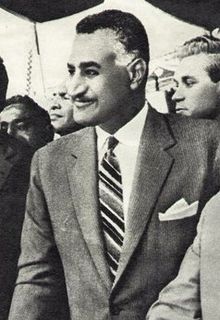
During his tenure as Prime Minister, and later President, Nasser continued the efforts to limit the power of the ulema of al-Azhar and to use its influence to his advantage. In 1952, the waqfs were nationalized and placed under the authority of the newly created Ministry of Religious Endowments, cutting off the ability of the mosque to control its financial affairs.[71][72] He abolished the sharia courts, merging religious courts with the state judicial system in 1955, severely limiting the independence of the ulema.[72] The 1961 reform law, which invalidated an earlier law passed in 1936 that had guaranteed the independence of al-Azhar, gave the President of Egypt the authority to appoint the sheikh al-Azhar, a position first created during Ottoman rule and chosen from and by the ulema since its inception.[73][74] Al-Azhar, which remained a symbol of the Islamic character of both the nation and the state, continued to influence the population while being unable to exert its will over the state. Al-Azhar became increasingly co-opted into the state bureaucracy after the revolution—independence of its curriculum and its function as a mosque ceased.[75] The authority of the ulema were further weakened by the creation of government agencies responsible for providing interpretations of religious laws.[76] While these reforms dramatically curtailed the independence of the ulema, they also had the effect of reestablishing their influence by integrating them further into the state apparatus.[77] The 1961 reform law also provided the ulema with the resources of the state, though the purse strings were outside of their control.[78] While Nasser sought to subjugate the ulema beneath the state, he did not allow more extreme proposals to limit the influence of al-Azhar. One such proposal was made by Taha Hussein in 1955. Hussein sought to dismantle the Azharite primary and secondary educational system and transform the university into a faculty of theology which would be included within the modern, secular, collegiate educational system. The ulema opposed this plan, though Nasser's choice of maintaining al-Azhar's status was due more to personal political considerations, such as the use of al-Azhar to grant legitimacy to the regime, than on the opposition of the ulema.[79]
Al-Azhar, now fully integrated as an arm of the government, was then used to justify actions of the government. Although the ulema had in the past issued rulings that socialism is irreconcilable with Islam, following the Revolution's land reforms new rulings were supplied giving Nasser a religious justification for what he termed an "Islamic" socialism.[80] The ulema would also serve as a counterweight to the Muslim Brotherhood, and to Saudi Arabia's Wahhabi influence.[81] An assassination attempt on Nasser was blamed on the Brotherhood, and the organization was outlawed. Nasser, needing support from the ulema as he initiated mass arrests of Brotherhood members, relaxed some of the restrictions placed on al-Azhar. The ulema of al-Azhar in turn consistently supported him in his attempts to dismantle the Brotherhood, and continued to do so in subsequent regimes.[76][82] Despite the efforts of Nasser and al-Azhar to discredit the Brotherhood, the organization continued to function.[83] Al-Azhar also provided legitimacy for war with Israel in 1967, declaring the conflict against Israel a "holy struggle".[84]
Following Nasser's death in 1970, Anwar Sadat became President of Egypt. Sadat wished to restore al-Azhar as a symbol of Egyptian leadership throughout the Arab world, saying that "the Arab world cannot function without Egypt and its Azhar".[85] Recognizing the growing influence of the Muslim Brotherhood, Sadat relaxed several restrictions on the Brotherhood and the ulema as a whole. However, in an abrupt about-face, in September 1971 a crackdown was launched on journalists and organizations that Sadat felt were undermining or attacking his positions. As part of this effort to silence criticism of his policies, Sadat instituted sanctions against any of the ulema who criticized or contradicted official state policies. The ulema of al-Azhar continued to be used as a tool of the government, sparking criticism among several groups, including Islamist and other more moderate groups.[84] Shukri Mustafa, an influential Islamist figure, accused the ulema of providing religious judgments for the sole purpose of government convenience.[85] When Sadat needed support for making peace with Israel, which the vast majority of the Egyptian population regarded as an enemy, al-Azhar provided a decree stating that the time had come to make peace.[84]
Al-Azhar continues to hold a status above other Sunni religious authorities throughout the world, and as Sunnis form a large majority of the total Muslim population al-Azhar exerts considerable influence on the Islamic world as a whole.[88] In addition to being the default authority within Egypt, al-Azhar has been looked to outside of Egypt for religious judgments. Prior to the Gulf War, Saudi Arabia's King Fahd asked for a fatwa authorizing the stationing of foreign troops within the kingdom, and despite Islam's two holiest sites being located within Saudi Arabia, he asked the head sheikh of al-Azhar instead of the Grand Mufti of Saudi Arabia.[89] In 2003, Nicolas Sarkozy, at the time French Minister of the Interior, requested a judgment from al-Azhar allowing Muslim girls to not wear the hijab in French public schools, despite the existence of the French Council of Islam. The sheikh of al-Azhar provided the ruling, saying that while wearing the hijab is an "Islamic duty" the Muslim women of France are obligated to respect and follow French laws. The ruling drew much criticism within Egypt as compromising Islamic principles to convenience the French government, and in turn the Egyptian government.[90]
Post 2011 revolution
Al-Azhar was not unaffected by the

In 2018 a major restoration of the mosque was completed, financed by both King Abdullah and King Salman of Saudi Arabia. Among the goals of the restoration was the reinforcement of the building's foundations, the restoration of its architectural elements, and upgrades to its infrastructure.[94][95] The Bab al-Muzayinīn (Gate of the Barbers), formerly one of the main public entrances to the mosque, has been made less accessible as a result of the restoration project.[96]
In 2020, representatives from the mosque spoke out against sexual violence in Egypt, prompted by the social media campaign instigated by student Nadeen Ashraf.[97]
Architecture
Foundation and structural evolution under Fatimids
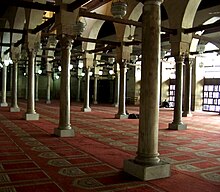
The original structure of the mosque was 280 feet (85 m) in length and 227 feet (69 m) wide,
Ultimately a total of three domes were built, a common trait among early north African mosques, although none of them have survived Al-Azhar's many renovations.[102][103] The historian al-Maqrizi recorded that in the original dome al-Siqilli inscribed the following:
In the name of Allah, the Merciful, the Compassionate; according to the command for its building from the servant of Allah, His governor abu Tamim Ma'ad, the Imam al-Mu‘izz li-Dīn Allāh, Amir al-Mu'minin, for whom and his illustrious forefathers and his sons may there be the blessings of Allah: By the hand of his servant Jawhar, the Secretary, the Ṣiqillī in the year 360.
Gawhar included the honorific Amir al-Mu'minin, Commander of the Faithful, as the Caliphs title and also included his nickname "the Secretary" which he had earned serving as a secretary prior to becoming a general.[104]

K. A. C. Creswell wrote that the original structure certainly had one dome, and likely a second for symmetry.[6]
The original Successful indeed are the believers – who are humble in their prayers – and who avoid vain talk The next inscription is made up of verses 162 and 163 of al-An'am: Say: Surely my prayer and my sacrifice and my life and my death are (all) for Allah, the Lord of the worlds – No associate has He; and this am I commanded, and I am the first of those who submit. These inscriptions are the only surviving piece of decoration that has been definitively traced to the Fatimids.[105]

The marble paved central courtyard was added between 1009 and 1010.
A new wooden door was installed during the reign of al-Hakim in 1009.[108] In 1125, al-Amir installed a new wooden mihrab. An additional dome was constructed during the reign of al-Hafiz li-Din Allah. He additionally ordered the creation of a fourth arcade around the courtyard and had a porch built on the western end of the sahn.[102][109]
Mamluk additions

The Fatimid dynasty was succeeded by the rule of Saladin and his
Madrasa al-Taybarsiyya

The Madrasa al-Taybarsiyya, which contains the tomb of
The madrasa was completely rebuilt by Abd al-Rahman Katkhuda, leaving only the southeastern wall and its mihrab untouched. The mihrab was described by
Madrasa and mausoleum of Aqbugha
A dome and minaret cover the Madrasa al-Aqbughawiyya, which contains the tomb of Amir Aqbugha, which was built in 1339.[112] Intended by its founder, another Mamluk amir called Sayf al-Din Aqbugha 'Abd al-Wahid, to be a stand-alone mosque and school, the madrasa has since become integrated with the rest of the mosque.[116] It includes both a small tomb chamber and a larger hall, both with mihrabs. The entrance, qibla wall, and the mihrabs with glass mosaics are all original, while the pointed dome was rebuilt in the Ottoman period.[112][117] Parts of the facade were remodeled by Khedive Tewfik in 1888.[107] The top of the minaret was remodelled by Abd al-Rahman Katkhuda so as to have a pointed top like the other Ottoman-style minarets he built around the entrances of the mosque, but at some point after 1932 the top was once again refashioned to end with a Mamluk-style finial which we see today.[118]
Madrasa Gawhariyya

Built in 1440,
Minaret of Qaytbay
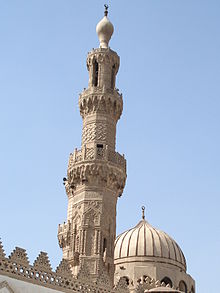
Built in 1483[120] or in 1495,[107][121] it has a square base, a transitional segment leading into an octagonal shaft, then a 10-sided polygon shaft, followed by a cylindrical shaft that consists of 8 brick pillars, each two adjoined by bricks in between. The Minaret of Qaytbay also has three balconies, supported by muqarnas,[120] a form of stalactite vaulting which provide a smooth transition from a flat surface to a curved one[122] (first recorded to have been used in Egypt in 1085),[123] that adorn the minaret. The first shaft is octagonal is decorated with keel-arched panels on each side, with a cluster of three columns separating each panel.[120] Above this shaft is the second octagonal shaft which is separated from the first by a balcony and decorated with plaiting.[120] A second balcony separates this shaft with the final cylindrical shaft, decorated with four arches. Above this is the third balcony, crowned by the finial top of the minaret.[120]
The minaret is believed to have been built in the area of an earlier, Fatimid-era brick minaret that had itself been rebuilt several times. Contemporary accounts suggest that the Fatimid minaret had defects in its construction and needed to be rebuilt several times,[124] including once under the direction of Sadr al-Din al-Adhra'i al-Dimashqi al-Hanafi, the qadi al-qudat (Chief Justice of the Highest Court) during the rule of Sultan Baibars.[125] Recorded to have been rebuilt again under Barquq in 1397, the minaret began to lean at a dangerous angle and was rebuilt in 1414 by Taj al-Din al-Shawbaki, the walī and muhtasib of Cairo, and again in 1432. The Qaytbay minaret was built in its place as part of a reconstruction of the entrance to the mosque.[124]
Gate of Qaytbay
Directly across the courtyard from the entrance from the Bab al-Muzayinīn is the Gate of Qaytbay.[116] It is a refined example of the late Mamuk architectural and decorative style. Built in 1495, this gate leads to the court of the prayer hall.[100]
Minaret of al-Ghuri

The double finial minaret was built in 1509 by Qansuh al-Ghuri.[100] Sitting on a square base, the first shaft is octagonal, and four sides have a decorative keel arch, separated from the adjacent sides with two columns.[120] The second shaft, a 12-sided polygon separated from the first by fretted balconies supported by muqarnas, is decorated with blue faience. A balcony separates the third level from the second shaft. The third level is made up of two rectangular shafts with horseshoe arches on each side of both shafts. Atop each of these two shafts rests a finial atop two identical onion shaped bulbs, with a balcony separating the finials from the shafts.[120]
Ottoman renovations and additions
Several additions and restorations were made during Ottoman reign in Egypt, many of which were completed under the direction of Abd al-Rahman Katkhuda who nearly doubled the size of the mosque.[126] Three gates were added by Katkhuda, the Bab al-Muzayinīn (see below), which became the main entrance to the mosque, the Bab al-Shurba (the Soup Gate), and the Bab al-Sa'ayida (the Gate of the Sa'idis).[35] To each gate he added a pointed Ottoman-style minaret, of which one was later demolished during the creation of al-Azhar Street. For the Bab al-Muzayinīn, which was adjacent to the Madrasa al-Aqbughiyya, he remodelled the top of Aqbugha's minaret to make it resemble the other Ottoman minarets (though the top was later rebuilt again in a Mamluk style during the 20th century).[127] Several riwaqs were added, including one for the blind students of al-Azhar, as well as refurbished during the Ottoman period.[36] Katkhuda also added an additional prayer hall south of the original Fatimid hall, with an additional mihrab, doubling the total prayer area.[36][126] His overall work reintegrated the mosque's disparate elements in a relatively unified whole.[36]
Bab al-Muzayinīn

The Bab al-Muzayinīn ("Gate of the Barbers", Arabic: باب المزينين) was built in 1753.[128][129] Credited to Katkhuda the gate has two doors, each surrounded by recessed arches. Two molded semi-circular arches with tympanums decorated with trefoils stand above the doors. Above the arches is a frieze with panels of cypress trees, a common trait of Ottoman work.[116]
A free-standing minaret, built by Katkhuda, originally stood outside the gate. The minaret was demolished prior to the opening of al-Azhar street by Tewfik Pasha during modernization efforts which took place throughout Cairo.[58]
Current layout and structure
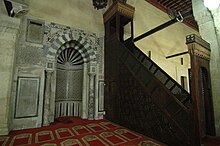
The present main entrance to the mosque is the Bab al-Muzayinīn, which opens into the white marble-paved courtyard at the opposite end of the main prayer hall.[116][130] To the northeast of the Bab al-Muzayinīn, the courtyard is flanked by the façade of the Madrasa al-Aqbughawiyya; the southwestern end of the courtyard leads to the Madrasa al-Taybarsiyya.[27] Directly across the courtyard from the entrance to the Bab al-Muzayinīn is the Bab al-Gindi (Gate of Qaytbay), built in 1495, above which stands the minaret of Qaytbay.[116] Through this gate lies the courtyard of the prayer hall.[100]
The mihrab has recently been changed to a plain marble facing with gold patterns, replacing some of the Mamluk marble facing, but the stucco carvings in the semi-dome are likely from the Fatimid era.[100]
See also
- Islam in Egypt
- Bab al-Futuh
- Sabil-Kuttab of Katkhuda
- History of medieval Arabic and Western European domes
Notes
- Ismaili branch of Shia Islam
- Mosque of Amr ibn al-As is the oldest mosque in modern urban Cairo (as well as the oldest mosque in Africa), built in 642 CE. However, the Mosque of Amr ibn al-As, as well as several others in modern-day Cairo that are older than al-Azhar, was built in the city of Fustatwhich the modern-city of Cairo later incorporated.
- ^ One of the main identifying characteristics of Egyptian Arabic is the hard g in place of j in the pronunciation of the letter ǧīm. This modification happened in the 19th and 20th centuries.[8]
Footnotes
- ^ Creswell 1952, p. 43.
- ^ a b c Rabbat 1996, p. 53.
- ^ Bloom 2007, p. 104.
- ^ Blair 2000, p. 507.
- ^ Hitti 1973, p. 114.
- ^ a b c d Creswell 1952, p. 36.
- ^ a b Dodge 1961, p. 5.
- ^ Izre'el & Raz 1996, p. 153.
- ^ a b Summerfield, Devine & Levi 1998, p. 9.
- ^ a b c Petry & Daly 1998, p. 139.
- ^ a b Yeomans 2006, p. 52.
- ^ a b Yeomans 2006, p. 53.
- ^ Daftary 1998, p. 96.
- ^ Dodge 1961, pp. 6–7.
- ^ Daftary 1998, p. 95.
- ^ a b Behrens-Abouseif 1992, p. 58.
- ^ a b c Creswell 1952, p. 37.
- ^ a b Williams 2018, p. 204.
- ^ a b c d e f g h i Summerfield, Devine & Levi 1998, p. 10.
- ^ a b c d e f Rabbat 1996, p. 56.
- ^ a b c Behrens-Abouseif 1992, p. 60.
- ^ a b c Dodge 1961, p. 36.
- ^ Dodge 1961, pp. 40–41.
- ^ Dodge 1961, p. 40.
- ^ Lulat 2005, p. 77.
- ^ a b Creswell 1952, pp. 37–38.
- ^ a b c d Rabbat 1996, p. 57.
- ^ a b Rabbat 1996, p. 58.
- ^ Rabbat 1996, p. 48.
- ^ a b c d e f Rabbat 1996, p. 59.
- ^ a b Winter 2004, p. 115.
- ^ Winter 2004, p. 12.
- ^ Winter 2004, p. 14.
- ^ Rabbat 1996, pp. 59–60.
- ^ a b Rabbat 1996, pp. 49–50.
- ^ a b c d Rabbat 1996, pp. 60–61.
- ^ Abu Zayd, Amirpur & Setiawan 2006, p. 36.
- ^ Rahman 1984, p. 36.
- ^ Heyworth-Dunne 1938, p. 681.
- ^ Winter 2004, p. 120.
- ^ Winter 2004, p. 121.
- ^ a b Raymond 2000, p. 293.
- ^ a b Watson 2003, pp. 13–14.
- ^ a b c d Rabbat 1996, p. 61.
- ^ Dwyer 2008, p. 380.
- ^ Watson 2003, p. 14.
- ^ McGregor 2006, p. 43.
- ^ Flower 1976, p. 49.
- ^ Dwyer 2008, p. 403.
- ^ a b Dwyer 2008, p. 404.
- ^ Richmond 1977, p. 25.
- ^ Asprey 2000, p. 293.
- ^ Flower 1976, p. 27.
- ^ a b c Summerfield, Devine & Levi 1998, p. 11.
- ^ Petry & Daly 1998, p. 148.
- ^ a b Raymond 2000, p. 312.
- ^ Shillington 2005, p. 199.
- ^ a b Rabbat 1996, p. 62.
- ^ a b c Summerfield, Devine & Levi 1998, p. 12.
- ^ a b c d e Rabbat 1996, p. 63.
- ^ Abu Zayd, Amirpur & Setiawan 2006, p. 19.
- ^ a b Rahman 1984, p. 64.
- ^ a b Voll 1994, p. 183.
- ^ Goldschmidt 2000, p. 123.
- ^ a b Summerfield, Devine & Levi 1998, p. 13.
- ^ Abdo 2002, pp. 50–51.
- ^ Zaman 2002, p. 60.
- ^ Tibi 2006, p. 173.
- ^ Zaman 2002, p. 86.
- ^ Zeghal 2007, p. 110.
- ^ Abdo 2002, pp. 49–50.
- ^ a b Zeghal 1999, p. 372.
- ^ Ghazzal 2005, p. 79.
- ^ Lulat 2005, p. 79.
- ^ Binder 1988, p. 340.
- ^ a b Abdo 2002, p. 51.
- ^ Zeghal 1999, p. 374.
- ^ Zeghal 1999, p. 375.
- ^ Zeghal 1999, p. 376.
- ^ Abdo 2002, p. 52.
- ^ Aburish 2004, p. 200.
- ^ Shillington 2005, p. 478.
- ^ Aburish 2004, p. 88.
- ^ a b c Abdo 2002, p. 31.
- ^ a b Abdo 2002, p. 54.
- ^ Barraclough 1998, pp. 239–240.
- ^ Barraclough 1998, pp. 242–243.
- ^ Rahman 1984, p. 31.
- ^ Tibi 2006, p. 165.
- ^ Zeghal 2007, p. 123.
- ^ a b Brown 2011, p. 10.
- ^ Brown 2011, p. 11.
- ^ Brown 2011, pp. 11–15.
- ^ "Al-Azhar Mosque shines after years-long restoration - Politics - Egypt". Ahram Online. Retrieved 18 June 2022.
- ^ Al-Mashareq. "Al-Sisi, Saudi Crown Prince inaugurate Al-Azhar Mosque renovation". Al-Mashareq. Retrieved 18 June 2022.
- ISBN 978-1-000-59485-0.
- ^ El Habachi 2020.
- ^ Rabbat 1996, pp. 47–50.
- ^ Holt, Lambton & Lewis 1977, p. 713.
- ^ a b c d e f g Rabbat 1996, pp. 47–48.
- ^ Rivoira & Rushforth 1918, p. 154.
- ^ a b c Behrens-Abouseif 1992, p. 59.
- ^ Petersen 2002, p. 45.
- ^ Dodge 1961, pp. 3–4.
- ^ a b Rabbat 1996, p. 64.
- ^ Abdo 2002, p. 45.
- ^ a b c d e f g Rabbat 1996, p. 47.
- ^ Dodge 1961, pp. 19–22.
- ^ Dodge 1961, p. 31.
- ^ Shillington 2005, p. 438.
- ^ Petry & Daly 1998, p. 312.
- ^ a b c d e Yeomans 2006, p. 56.
- ^ a b Holt, Lambton & Lewis 1977, p. 731.
- ^ a b c Creswell 1959, p. 253.
- ^ Creswell 1959, pp. 253–254.
- ^ a b c d e Rabbat 1996, p. 46.
- ^ Williams 2018, p. 203-204.
- ^ Rabbat 1996, p. 67.
- ^ a b Williams 2018, p. 205-206.
- ^ a b c d e f g Yeomans 2006, p. 55.
- ^ Williams 2018, p. 206.
- ^ Petersen 2002, p. 208.
- ^ Bloom 1988, p. 21.
- ^ a b Rabbat 1996, p. 51.
- ^ Rabbat 1996, p. 50.
- ^ a b Yeomans 2006, p. 54.
- ^ Rabbat 1996, pp. 60–61, 62, 67.
- ^ Russell 1962, p. 185.
- ^ Gottheil 1907, p. 503.
- ^ Beattie 2005, p. 103.
Sources
- ISBN 978-0-19-515793-2
- ISBN 978-90-5356-828-6
- ISBN 978-0-312-28683-5
- ISBN 978-0-465-04881-6
- Barraclough, Steven (1998), "Al-Azhar: Between the Government and the Islamists", Middle East Journal, 52 (2): 236–249, JSTOR 4329188
- Beattie, Andrew (2005), Cairo: a cultural history, Oxford University Press, ISBN 978-0-19-517893-7
- Behrens-Abouseif, Doris (1992), Islamic Architecture in Cairo (2nd ed.), ISBN 978-90-04-09626-4
- ISBN 978-0-226-05147-5
- Blair, Sheila (2000), "Decorations of city walls in the medieval Islamic world: The epigraphic message", in Tracy, James D. (ed.), City walls: the urban enceinte in global perspective, Cambridge University Press, ISBN 978-0-521-65221-6
- Bloom, Jonathan (1988), "The Introduction of the Muqarnas into Egypt", in Grabar, Oleg (ed.), Muqarnas: An Annual on Islamic Art and Architecture, vol. 5, Brill, pp. 21–28, ISBN 978-90-04-08647-0
- Bloom, Jonathan (2007), "Ceremonial and Sacred Space in Early Fatimid Cairo", in Bennison, Amira K.; Gascoigne, Alison L. (eds.), Cities in the pre-modern Islamic world, ISBN 978-0-415-42439-4
- Brown, Nathan (September 2011), Post-revolutionary al-Azhar (PDF), The Carnegie Papers, Carnegie Endowment for International Peace
- Clarendon Press
- Creswell, K. A. C. (1959), The Muslim Architecture of Egypt II, Ayyubids and Early Bahrite Mamluks, A.D. 1171–1326, Clarendon Press
- ISBN 978-1-55876-194-0
- Dodge, Bayard (1961), Al-Azhar: A Millennium of Muslim learning, Middle East Institute
- Dwyer, Philip G. (2008), Napoleon: the path to power, ISBN 978-0-300-13754-5
- El Habachi, May (17 December 2020), "Egypt's #MeToo Activists See Progress, but 'the Road Ahead Is Long'", World Politics Review, retrieved 15 January 2022
- Flower, Raymond (1976), Napoleon to Nasser: the story of modern Egypt, ISBN 978-0-905562-00-1
- Ghazzal, Zuhair (2005), "The 'Ulema': Status and Function", in Choueiri, Youssef (ed.), A companion to the history of the Middle East, ISBN 978-1-4051-0681-8
- Goldschmidt, Arthur (2000), Biographical dictionary of modern Egypt, ISBN 978-1-55587-229-8
- Dodd, Mead and Company
- Heyworth-Dunne, James (1938), "Arabic Literature in Egypt in the Eighteenth Century with Some Reference to the Poetry and Poets", Bulletin of the School of Oriental Studies, University of London, 9 (3): 675–689, S2CID 161601609
- ISBN 978-0-8166-0663-4
- Holt, Peter Malcolm; ISBN 978-0-521-29138-5
- Izre'el, Shlomo; Raz, Shlomo (1996), Studies in modern Semitic languages, Brill, ISBN 978-90-04-10646-8
- Lulat, Y. G-M. (2005), A history of African higher education from antiquity to the present: a critical synthesis, ISBN 978-0-313-32061-3
- McGregor, Andrew James (2006), A military history of modern Egypt: from the Ottoman Conquest to the Ramadan War, ISBN 978-0-275-98601-8
- Petersen, Andrew (2002), Dictionary of Islamic Architecture, Routledge, ISBN 978-0-203-20387-3
- Petry, Carl F.; Daly, M. W., eds. (1998), The Cambridge history of Egypt, vol. 1, Cambridge University Press, ISBN 978-0-521-47137-4
- Rabbat, Nasser (1996), "Al-Azhar Mosque: An Architectural Chronicle of Cairo's History", in Necipogulu, Gulru (ed.), Muqarnas- An Annual on the Visual Culture of the Islamic World, vol. 13, Brill, pp. 45–67, ISBN 978-90-04-10633-8
- Rahman, Fazlur (1984), Islam & modernity: transformation of an intellectual tradition, University of Chicago Press, ISBN 978-0-226-70284-1
- Raymond, André (2000), Cairo, ISBN 978-0-674-00316-3
- ISBN 978-0-416-85660-6
- Rivoira, Giovanni Teresio; Rushforth, Gordon McNeil (1918), Moslem architecture, Oxford University Press, ISBN 978-0-87817-136-1
- Russell, Dorothea (1962), Medieval Cairo and the Monasteries of the Wādi Natrūn, Weidenfeld & Nicolson
- Shillington, Kevin, ed. (2005), Encyclopedia of African history, CRC Press, ISBN 978-1-57958-453-5
- Siddiqi, Muhammad (2007), Arab culture and the novel: genre, identity and agency in Egyptian fiction, Routledge, ISBN 978-0-415-77260-0
- Skovgaard-Petersen, Jakob (1997), Defining Islam for the Egyptian state: muftis and fatwas of the Dār al-Iftā, Brill, ISBN 978-90-04-10947-6
- Summerfield, Carol; Devine, Mary; Levi, Anthony, eds. (1998), International Dictionary of University Histories, Taylor & Francis, ISBN 978-1-884964-23-7
- ISBN 978-0-415-95280-4
- Viorst, Milton (2001), In the shadow of the Prophet: the struggle for the soul of Islam, ]
- Voll, John Obert (1994), Islam, continuity and change in the modern world: Contemporary issues in the Middle East, ISBN 978-0-8156-2639-8
- Watson, William E. (2003), Tricolor and crescent: France and the Islamic world; Perspectives on the twentieth century, Greenwood Publishing Group, ISBN 978-0-275-97470-1
- Williams, Caroline (2002), Islamic Monuments in Cairo: The Practical Guide, ISBN 978-977-424-695-1
- Williams, Caroline (2018), Islamic Monuments in Cairo: The Practical Guide (7th ed.), ISBN 978-977-416-855-0
- Winter, Michael (2004), Egyptian Society Under Ottoman Rule, 1517–1798, Routledge, ISBN 978-0-203-16923-0
- Yeomans, Richard (2006), The art and architecture of Islamic Cairo, Garnet & Ithaca Press, ISBN 978-1-85964-154-5
- Zaman, Muhammad Qasim (2002), The ulama in contemporary Islam: custodians of change, Princeton University Press, ISBN 978-0-691-09680-3
- S2CID 33718066
- ISBN 978-0-691-12933-4


